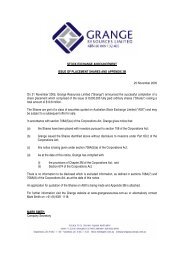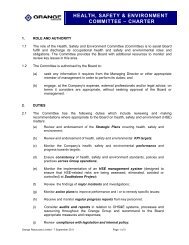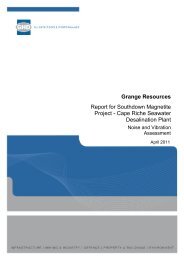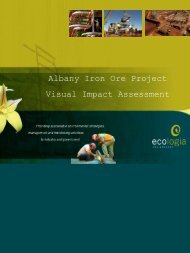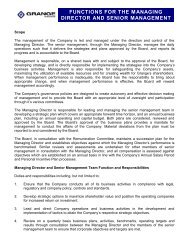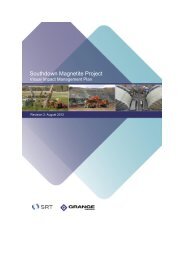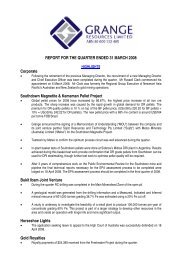Appendix A - Flora and Fauna Survey - Grange Resources
Appendix A - Flora and Fauna Survey - Grange Resources
Appendix A - Flora and Fauna Survey - Grange Resources
You also want an ePaper? Increase the reach of your titles
YUMPU automatically turns print PDFs into web optimized ePapers that Google loves.
� Reduction in the extent of vegetation communities <strong>and</strong> associated habitats: the desalination<br />
plant <strong>and</strong> pipeline has been positioned to avoid or limit impacts to native vegetation, particularly<br />
conservation significant vegetation <strong>and</strong> important habitats. Up to 15.9 ha of native vegetation<br />
will require removal.<br />
� This clearing includes 0.93 ha of the Priority 3 ecological community – Swamp Yate (Eucalyptus<br />
occidentalis) woodl<strong>and</strong>s in seasonally inundated clay basins (South Coast). Ecologia (2008a)<br />
assessed the extent of the Swamp Yate (Eucalyptus occidentalis) woodl<strong>and</strong>s in seasonally<br />
inundated clay basins (South Coast) within the East S<strong>and</strong> Plain Sub-catchment, <strong>and</strong> identified<br />
the presence of 44 ha of this community in Good to Excellent condition. Taking a conservative<br />
approach (using the 44 ha extent), the 0.93 ha of the Swamp Yate PEC to be cleared for this<br />
Project is estimated to be approximately 2% of that present in the sub-catchment.<br />
� Four Priority species <strong>and</strong> an unconfirmed Lasiopetalum species were identified from within the<br />
alignment. These were recorded in low densities in four quadrat sites. Given the limited extent of<br />
vegetation clearing associated with the Project <strong>and</strong> presence of similar habitat surrounding the<br />
alignment (including within the offset site) clearing for the Project is not expected to result in<br />
significant losses to priority species. An additional conservation significant flora targeted search<br />
will be undertaken in Spring 2011 to further assess <strong>and</strong> map conservation significant flora.<br />
� Fragmentation <strong>and</strong> barrier effects: given the location along existing tracks <strong>and</strong> cleared areas <strong>and</strong><br />
minimal length of time the trench will be open, further fragmentation or restrictions to fauna<br />
movement are not expected.<br />
� <strong>Fauna</strong> injury <strong>and</strong> mortality: through entrapment <strong>and</strong> vehicle strike during the construction period.<br />
� Dieback <strong>and</strong> weeds: potential to cause spread <strong>and</strong> introduction of weeds <strong>and</strong> dieback.<br />
Mitigation<br />
A general principle of environmental management is to, in order of preference:<br />
� Avoid environmental impacts;<br />
� Minimise impacts;<br />
� Mitigate the impacts; <strong>and</strong><br />
� Where impacts cannot be avoided or minimised, compensate for the residual impacts using<br />
other mitigation measures such as offsets.<br />
Potential impacts will be managed through Construction Environmental Management Plans/Project<br />
Environmental Management System (CEMP <strong>and</strong> PEMS).<br />
Conclusion<br />
Given the extent of native vegetation requiring clearing (15.9 ha) <strong>and</strong> presence of similar habitats within<br />
the broader area, the project is not expected to result in significant impacts to conservation significant<br />
species or communities, or to the biodiversity of the local or regional area. Furthermore, with appropriate<br />
management, the residual impacts of the Project on flora <strong>and</strong> fauna are considered to be relatively minor<br />
<strong>and</strong> localised.<br />
iv



